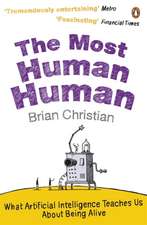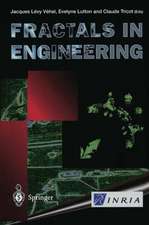From Animals to Animats 11: 11th International Conference on Simulation of Adaptive Behavior, SAB 2010, Paris - Clos Lucé, France, August 25-28, 2010. Proceedings: Lecture Notes in Computer Science, cartea 6226
Editat de Stephane Doncieux, Benoit Girard, Agnes Guillot, John Hallam, Jean-Arcady Meyer, Jean-Baptiste Moureten Limba Engleză Paperback – 11 aug 2010
Din seria Lecture Notes in Computer Science
- 20%
 Preț: 1061.55 lei
Preț: 1061.55 lei - 20%
 Preț: 307.71 lei
Preț: 307.71 lei - 20%
 Preț: 438.69 lei
Preț: 438.69 lei - 20%
 Preț: 579.30 lei
Preț: 579.30 lei -
 Preț: 410.88 lei
Preț: 410.88 lei - 17%
 Preț: 427.22 lei
Preț: 427.22 lei - 20%
 Preț: 596.46 lei
Preț: 596.46 lei - 15%
 Preț: 448.04 lei
Preț: 448.04 lei - 20%
 Preț: 353.50 lei
Preț: 353.50 lei -
 Preț: 389.49 lei
Preț: 389.49 lei - 20%
 Preț: 309.90 lei
Preț: 309.90 lei - 20%
 Preț: 645.28 lei
Preț: 645.28 lei - 20%
 Preț: 763.23 lei
Preț: 763.23 lei - 15%
 Preț: 580.46 lei
Preț: 580.46 lei - 20%
 Preț: 310.28 lei
Preț: 310.28 lei - 20%
 Preț: 655.02 lei
Preț: 655.02 lei - 20%
 Preț: 1183.14 lei
Preț: 1183.14 lei - 20%
 Preț: 340.32 lei
Preț: 340.32 lei -
 Preț: 449.57 lei
Preț: 449.57 lei - 20%
 Preț: 591.51 lei
Preț: 591.51 lei - 18%
 Preț: 938.83 lei
Preț: 938.83 lei - 20%
 Preț: 337.00 lei
Preț: 337.00 lei - 20%
 Preț: 649.50 lei
Preț: 649.50 lei - 20%
 Preț: 607.40 lei
Preț: 607.40 lei - 20%
 Preț: 1414.79 lei
Preț: 1414.79 lei - 20%
 Preț: 1024.44 lei
Preț: 1024.44 lei - 20%
 Preț: 583.40 lei
Preț: 583.40 lei - 20%
 Preț: 453.32 lei
Preț: 453.32 lei - 20%
 Preț: 575.49 lei
Preț: 575.49 lei - 20%
 Preț: 1075.26 lei
Preț: 1075.26 lei - 20%
 Preț: 585.88 lei
Preț: 585.88 lei - 20%
 Preț: 825.93 lei
Preț: 825.93 lei - 17%
 Preț: 360.20 lei
Preț: 360.20 lei - 20%
 Preț: 763.23 lei
Preț: 763.23 lei - 20%
 Preț: 340.32 lei
Preț: 340.32 lei - 20%
 Preț: 504.58 lei
Preț: 504.58 lei - 20%
 Preț: 369.13 lei
Preț: 369.13 lei - 20%
 Preț: 580.93 lei
Preț: 580.93 lei - 20%
 Preț: 343.62 lei
Preț: 343.62 lei - 20%
 Preț: 350.21 lei
Preț: 350.21 lei - 20%
 Preț: 583.40 lei
Preț: 583.40 lei - 20%
 Preț: 583.40 lei
Preț: 583.40 lei - 15%
 Preț: 438.59 lei
Preț: 438.59 lei - 20%
 Preț: 341.95 lei
Preț: 341.95 lei - 20%
 Preț: 238.01 lei
Preț: 238.01 lei - 20%
 Preț: 538.30 lei
Preț: 538.30 lei
Preț: 664.95 lei
Preț vechi: 831.19 lei
-20% Nou
Puncte Express: 997
Preț estimativ în valută:
127.25€ • 138.18$ • 106.89£
127.25€ • 138.18$ • 106.89£
Carte disponibilă
Livrare economică 01-15 aprilie
Preluare comenzi: 021 569.72.76
Specificații
ISBN-13: 9783642151927
ISBN-10: 3642151922
Pagini: 680
Ilustrații: XVI, 662 p. 308 illus.
Greutate: 0.95 kg
Ediția:2010
Editura: Springer Berlin, Heidelberg
Colecția Springer
Seriile Lecture Notes in Computer Science, Lecture Notes in Artificial Intelligence
Locul publicării:Berlin, Heidelberg, Germany
ISBN-10: 3642151922
Pagini: 680
Ilustrații: XVI, 662 p. 308 illus.
Greutate: 0.95 kg
Ediția:2010
Editura: Springer Berlin, Heidelberg
Colecția Springer
Seriile Lecture Notes in Computer Science, Lecture Notes in Artificial Intelligence
Locul publicării:Berlin, Heidelberg, Germany
Public țintă
ResearchCuprins
Animat Approaches for Adaptive Behaviour.- From Mirror Writing to Mirror Neurons.- How Virtual Machinery Can Bridge the “Explanatory Gap”, in Natural and Artificial Systems.- Do Empirical Models of Robot-Environment Interaction Have a Meaning?.- Information Dynamics of Evolved Agents.- Taming the Beast: Guided Self-organization of Behavior in Autonomous Robots.- Perception and Motor Control.- Slime Mold Inspired Chemical Sounding.- A Conserved Network for Control of Arthropod Exteroceptive Optical Flow Reflexes during Locomotion.- Modifying Directionality through Auditory System Scaling in a Robotic Lizard.- SCRATCHbot: Active Tactile Sensing in a Whiskered Mobile Robot.- Toward a Spiking-Neuron Model of the Oculomotor System.- An Integrated Neuromimetic Model of the Saccadic Eye Movements for the Psikharpax Robot.- Reconstructing the Acoustic Signal of a Sound Source: What Did the Bat Say?.- Simulating the Morphological Feasibility of Adaptive Beamforming in Bats.- On the Influence of Sensor Morphology on Vergence.- Adapting Preshaped Grasping Movements Using Vision Descriptors.- Multimodal Predictive Control in Crickets.- Tactile Discrimination Using Template Classifiers: Towards a Model of Feature Extraction in Mammalian Vibrissal Systems.- A Supramodal Vibrissa Tactile and Auditory Model for Texture Recognition.- Learning to Look in Different Environments: An Active-Vision Model Which Learns and Readapts Visual Routines.- Estimating Relative Positions of Multiple Objects in the Weakly Electric Fish.- From Force Control and Sensory-Motor Informations to Mass Discrimination.- The Approach Behaviour of the Hawkmoth Manduca sexta toward Multi-modal Stimuli: A Simulation Model.- The Indiana Experiment: Investigating the Role of Anticipation and Attention in a DynamicEnvironment.- Attentional Mechanisms for Lateral Line Sensing through Spectral Analysis.- BeeIP: Bee-Inspired Protocol for Routing in Mobile Ad-Hoc Networks.- Action Selection and Behavioural Sequences.- Simulating Human Table Tennis with a Biomimetic Robot Setup.- Attentional Modulation of Mutually Dependent Behaviors.- An Empirical Evidence of Braitenberg Vehicle 2b Behaving as a Billiard Ball.- Insectomorphic Robot Maneuvering on a Movable Ball.- A Study of Adaptive Locomotive Behaviors of a Biped Robot: Patterns Generation and Classification.- Navigation and Internal World Models.- Predicting Affordances from Gist.- Analyzing Interactions between Cue-Guided and Place-Based Navigation with a Computational Model of Action Selection: Influence of Sensory Cues and Training.- A Cortical Column Model for Multiscale Spatial Planning.- Why and How Hippocampal Transition Cells Can Be Used in Reinforcement Learning.- The Complementary Roles of Allostatic and Contextual Control Systems in Foraging Tasks.- Path Integration Working Memory for Multi Tasks Dead Reckoning and Visual Navigation.- Minimal Model of Strategy Switching in the Plus-Maze Navigation Task.- Learning and Adaptation.- Distributed Online Learning of Central Pattern Generators in Modular Robots.- Learning New Motion Primitives in the Mirror Neuron System: A Self-organising Computational Model.- A Computational Model of Integration between Reinforcement Learning and Task Monitoring in the Prefrontal Cortex.- Internal Models in the Cerebellum: A Coupling Scheme for Online and Offline Learning in Procedural Tasks.- eMOSAIC Model for Humanoid Robot Control.- Noisy-or Nodes for Conditioning Models.- Adaptation of Coupled Sensorimotor Mappings: An Investigation towards Developmental Learning of Humanoids.- LearningInverse Kinematics for Pose-Constraint Bi-manual Movements.- TeXDYNA: Hierarchical Reinforcement Learning in Factored MDPs.- Learning Robot-Environment Interaction Using Echo State Networks.- A Novel Information Measure for Predictive Learning in a Social System Setting.- Evolution.- Co-development of Linguistic and Behavioural Skills: Compositional Semantics and Behaviour Generalisation.- Indirectly Encoding Neural Plasticity as a Pattern of Local Rules.- Fractal Gene Regulatory Networks for Robust Locomotion Control of Modular Robots.- The Dependence of Braking Strategies on Optical Variables in an Evolved Model of Visually-Guided Braking.- Self-organizing Robot Teams Using Asynchronous Situated Co-evolution.- Emergence of an Internal Model in Evolving Robots Subjected to Sensory Deprivation.- Emergent Distribution of Computational Workload in the Evolution of an Undulatory Animat.- Multi-objective Evolutionary Algorithms to Investigate Neurocomputational Issues: The Case Study of Basal Ganglia Models.- Collective and Social.- Cooperative Stigmergic Navigation in a Heterogeneous Robotic Swarm.- How to Pick the Right One: Investigating Tradeoffs among Female Mate Choice Strategies in Treefrogs.- Autonomous Development of Social Referencing Skills.- A Model of Symmetry Breaking in Collective Decision-Making.- Simulation of How Neuromodulation Influences Cooperative Behavior.
Caracteristici
Fast-track conference proceedings State-of-the-art research Up-to-date results














